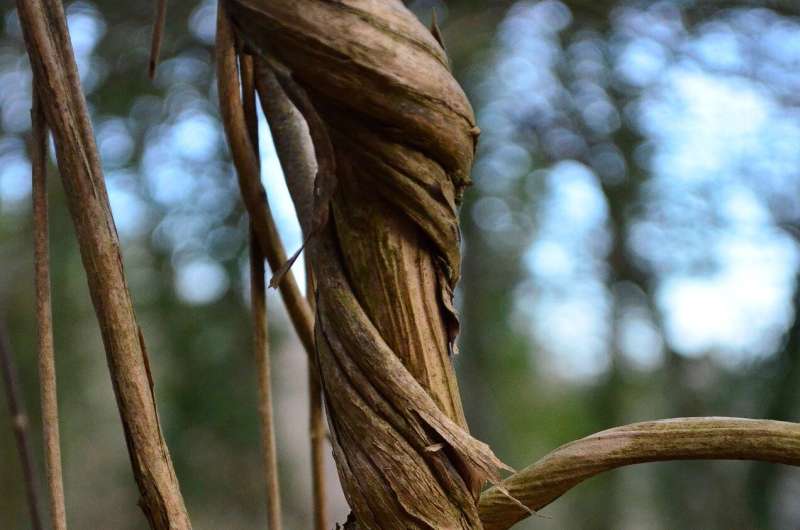This article has been reviewed according to Science X's editorial process and policies. Editors have highlighted the following attributes while ensuring the content's credibility:
fact-checked
peer-reviewed publication
trusted source
proofread
Vines strangle forests in warm temperatures, threaten planet's cooling 'carbon sink'

As Earth records its hottest year ever, a global research collaboration has found warmer temperatures are a key driver in woody vines taking over the world's forests—threatening their vital role in helping cool the atmosphere by storing carbon.
Spanning 44 countries across five continents, the University of the Sunshine Coast-led study, published in Global Change Biology has identified which of the world's forests are most vulnerable, based on their climate.
The identified hotspots are tropical forests at low elevation, examples of which can be found in East Africa, Vietnam, Colombia, Australia's Wet Tropics and many more locations across the world.
Professor Andy Marshall, from UniSC's Forest Research Institute, said the team had confirmed a "tipping point" in conditions that led to the dominance of liana, a woody vine that chokes trees and prevents them from growing, as it climbs to reach the forest canopy.
That crucial juncture for forests already disturbed by logging, clearing and other impacts is when mean annual temperature above 27.8° Celsius, and rainfall is less than 1,614 mm.
"Woody vines are increasingly taking over the world's forests. For the first time, we have a global assessment that confirms that forest disturbance and climatic factors are major drivers of liana dominance," Professor Marshall said.
"These findings are essential for successfully restoring the world's forests, allowing us to know where to concentrate our efforts for restoration, and future areas of concern, in a changing climate," Professor Marshall said.
"Importantly, it identifies the environmental conditions under which liana vines are likely to out-compete trees and stall recovery in disturbed native forests worldwide," Professor Marshall said.
"In Australia, the coastal and low-elevation forests of north Queensland are the most vulnerable—
adding to the ongoing threat of deforestation which, in Queensland, is already greater than any other developed country," he said.
"With warmer temperatures and ongoing disturbances from logging and clearing, those forests areas under threat from liana around the world are only going to increase."
Professor Marshall said the study was a culmination of more than 20 years of research and filled a critical gap in understanding the vine's dominance on an international scale.
"On my first ever expedition to a rainforest, in East Africa, in 1998, I noticed these vines growing over all the trees and wondered what on Earth was going on and why nobody was investigating. Since then, research has exploded in scale, however it is mostly locally or regionally focused," he said.
This global study used "an unprecedented dataset" from 651 vegetation samples representing 26,538 lianas and 82,802 trees, from 556 unique locations worldwide, derived from 83 research publications.
Twenty co-authors contributed to the research paper, representing research institutions from Australia, South Africa, United Kingdom, Singapore, Panama, Brazil, the United States and China.
Threats to Earth's carbon sink
The researchers said the results showed that lianas were better suited to deal with climate change, including warmer temperatures and lower rainfall, and other disturbance such as fire, logging and clearing.
Lianas dominate the trees and hinder their ability to recover following disturbances, a situation that can persist for decades.
"Understanding how this occurrence varies over time under different climates is crucial for predicting responses of degraded forest landscapes and for guiding forest management strategies in the face of global environmental changes," Professor Marshall said.
The impact of these vines on the carbon sink was another critical area highlighted in the findings.
Along with the ocean and soil, forests are the world's largest carbon sinks, absorbing and storing carbon dioxide from the atmosphere.
Already seriously impacted by forest loss and degradation by tree-felling, the findings suggest that the vines add to the threat to the carbon sink by preventing the trees from growing and slowing forest recovery following disturbance.
Seeking solutions
The next step is finding sensitive, effective solutions to help trees recover from vines and to help restore the global carbon sink.
However, Professor Marshall said full-scale clearing of the vines was not the answer.
"We certainly wouldn't want this work to lead to forest managers going and cutting out all these vines out of their forests," he said.
"Liana plays its part in the forest ecosystem and biodiversity by boosting soil fertility and carbon cycling, and can benefit other plants, animals, soils and overall ecosystem function, in both intact and disturbed forests.
"It is just that human impact is so great in some areas, that they are growing in very high numbers, they are not growing in a natural way."
UniSC is continuing research into the effects of vines on forests and how to manage their impact as part of Professor Marshall's Forest Restoration and Climate Experiment. These findings are the first step towards confirming the team's recently published theory on global forest recovery from disturbance and vines.
More information: Alain Senghor K. Ngute et al, Global dominance of lianas over trees is driven by forest disturbance, climate and topography, Global Change Biology (2024). DOI: 10.1111/gcb.17140
Journal information: Global Change Biology
Provided by University of the Sunshine Coast




















